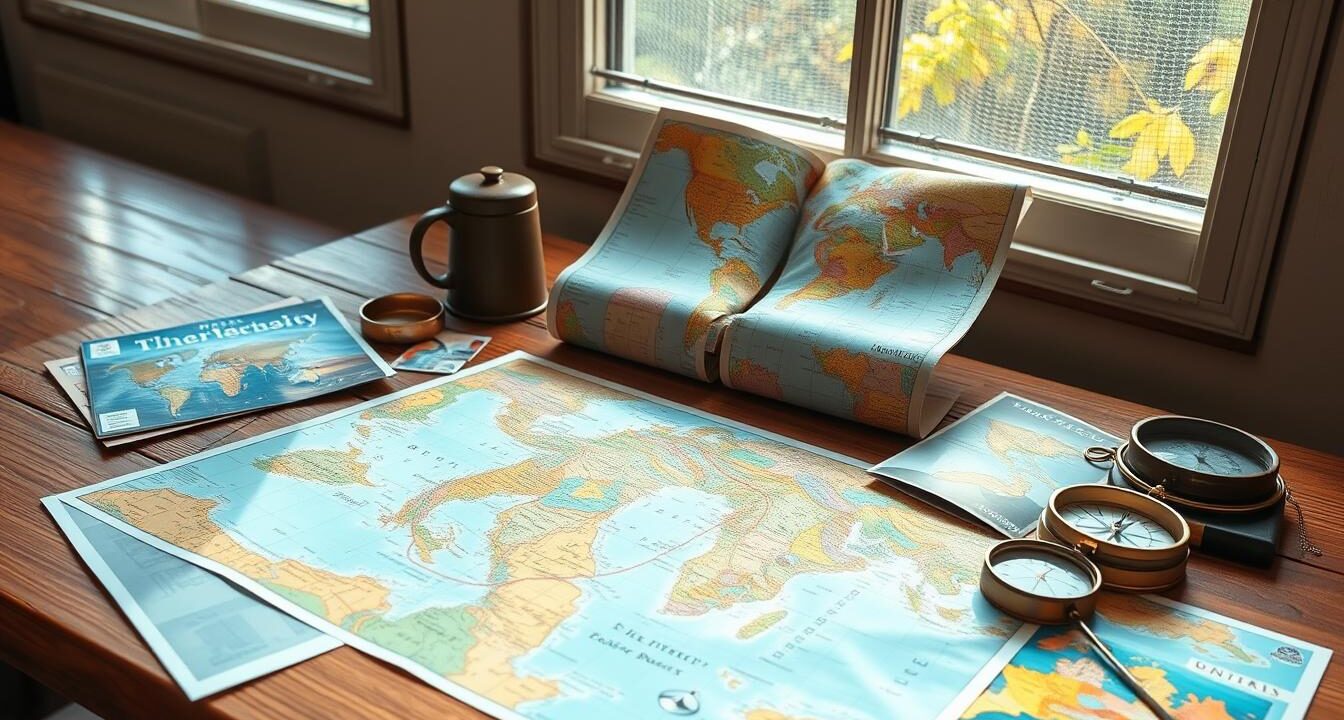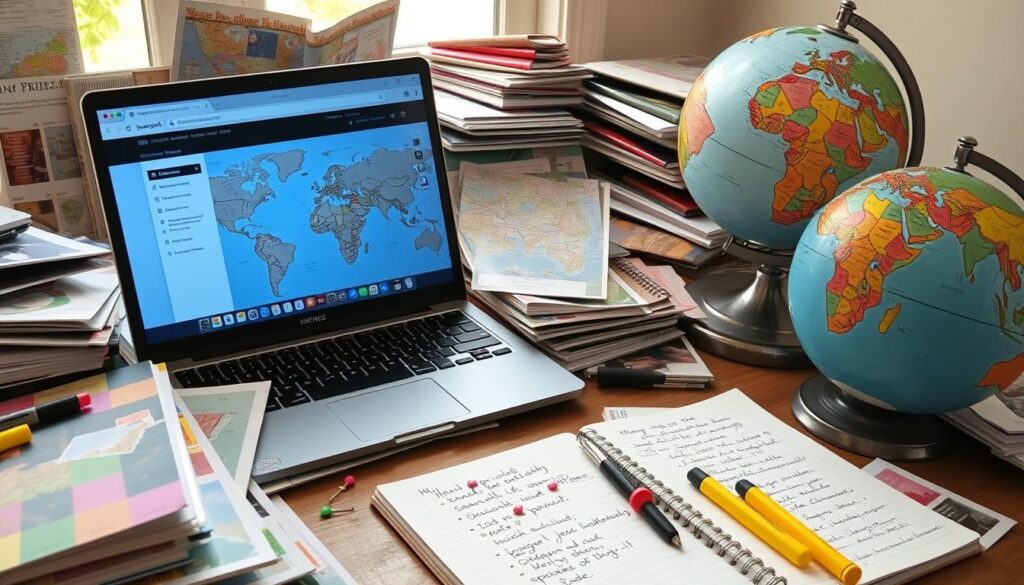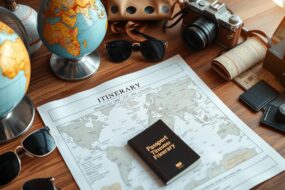
Planning a trip is like starting an exciting journey before you even leave. The more I plan, the more I look forward to it. By the time I’m ready to go, I’m bursting with excitement and confidence in my planning.
Of course, things can go wrong. Plans might change, but that’s okay. I’ve thought of what could go wrong and have backup plans. It’s not just about booking flights and packing bags. It’s about creating an unforgettable experience.
Whether it’s a quick weekend trip or a long vacation, a good travel plan is key. This guide will share expert tips for making the best itinerary for your next adventure.
Key Takeaways
- Crafting the perfect itinerary is essential for a smooth and enjoyable travel experience.
- Expert tips can help you optimize your trip planning, from destination selection to transportation modes.
- Balancing planning and flexibility is key to dealing with unexpected disruptions.
- Incorporating cultural experiences and local recommendations can deepen your appreciation for the destination.
- Using travel planning tools and resources can streamline the itinerary creation process.
The Importance of Trip Planning
Even if you’re not a natural planner, having a basic travel plan is key. Flights can cancel, or weather can ruin your plans. A plan helps you stay smooth and enjoy your trip, even when things go wrong.
Spread the Love for Planning
I love planning trips, but being flexible is just as important. Flights can cancel, or weather can change. You might also find new activities or experiences.
Don’t overplan. Leave some free time and options for activities or dining. This way, you won’t miss out on surprises.
Balancing Planning and Flexibility
Finding the right balance is key. Trip planning is important, but don’t be too rigid. Leave room for spontaneity to make your trip memorable.
Decide on Your Destination
Choosing the right travel destination is key to a memorable trip. You might have a place in mind or be looking for options. Consider factors like cost, time, season, and how easy it is to get around. These things can really change your trip.
Factors to Consider
When picking a travel spot, think about what you want. Do you want to relax, have an adventure, explore cities, or dive into local culture? Think about your budget, how long you’ll be there, and what you value most. Maybe you love trying new foods, seeing nature, or trying exciting activities.
Looking online can help you find places that fit what you’re looking for. Travel blogs, deal sites, and search engines can show you options you might not have thought of.
Researching Your Destination
After picking a place, start digging deeper. Get the basics like location, language, money, and travel documents. Then, read articles, personal stories, and guides to find the best spots and how to get around.
This detailed research will help you plan a trip that’s full of great moments. You’ll make the most of your time and have a trip you’ll always remember.
| Key Considerations | Helpful Resources |
|---|---|
| Cost, available time, season, and ease of navigation | Google Maps, travel blogs, deal websites like Voyage Privée |
| Type of experience (relaxation, adventure, city exploration, cultural immersion) | Airbnb, Skyscanner, TripAdvisor |
| Destination location, language, currency, and passport/visa requirements | Travel guides (digital and physical), local tourist services |

“Establishing a clear idea of vacation preferences before choosing a destination can significantly save time.”
The Best Itinerary Includes Timing and Pacing
Creating the perfect travel itinerary is all about finding the right balance. It’s important to plan activities, meals, and travel times well. You don’t want your clients to miss anything because the schedule is too tight.
Plan each part of the itinerary carefully. Make sure there’s enough time between activities. Too many activities can make the trip stressful and tiring. Finding the right balance of activities and downtime is key to creating an enjoyable, personalized trip.
A Booking.com survey found 75% of people want authentic local experiences. To meet this demand, include enough time for clients to enjoy the local culture. Rushing through activities can make them miss out on the true experience.
When planning the trip pacing, think about the trip’s length and destinations. For short trips of 3-5 days, include at least one rest day. For longer trips of 7-10 days, plan more rest days and spend 3-5 days at each place.
| Trip Duration | Recommended Rest Days | Days per Destination |
|---|---|---|
| 3-5 days | 1 rest day | N/A |
| 7-10 days | Multiple rest days | 3-5 days |
| Longer single-destination or multi-destination with extensive travel | Several rest days at each destination | N/A |
By carefully planning the travel itinerary timing and pacing, you can ensure your clients have a great time. They won’t feel rushed or overwhelmed. This attention to detail will make your travel planning stand out and leave a lasting impression.
Choosing Accommodation: Hotel vs. Rental Property
When I plan my trips, I think about hotel vs rental property options. For short stays of one to three nights, hotels are my go-to. They offer secure luggage storage, dining, and easy check-in and check-out. This is great when I’m short on time.
But for longer stays, I choose vacation rentals. They have more space and amenities, especially when traveling with others. Rentals let me do laundry and cook, making my stay more homely and comfortable. I look for features like a washer, workspace, fast internet, and a central location.
When to Choose a Hotel
For brief trips, a hotel room is enough. It has a bed, bathroom, and internet. Hotel services make it easy for my short-term stay options.
When to Choose a Rental Property
For longer stays, a rental’s extra space and amenities are key. The benefits of a vacation rental make my stay more relaxed. It’s perfect for getting into the local culture.

My choice between a hotel and a rental depends on my trip’s length and purpose. Hotels are quick and convenient for short stays. But for longer rental property selection, the extra space and amenities make my trip better.
Selecting a Base of Stay
Choosing the right base of stay is key when exploring a big area. It’s where you start your day trips and explore the region. Look for a place with easy transportation access and amenities like cafes and markets nearby.
Having a good base of stay saves time and money. You won’t have to keep going back to your place. Plus, you can easily get what you need without hassle. This lets you enjoy regional exploration more.
| Criteria for Selecting a Base of Stay | Importance |
|---|---|
| Easy transportation access | Facilitates convenient in-and-out movement, whether by car or public transit |
| Walkable amenities | Allows access to essential services, dining, and shopping within a short distance |
| Central location | Enables efficient regional exploration by minimizing travel time between destinations |
Focus on these points when picking a base of stay. It makes your trip smoother and more fun. You’ll get to enjoy your time exploring more.
Finding Activities and Attractions
Before any trip, I find it helpful to invest in a quality guidebook to get an overview of the destination. It helps me discover the major sights and activities. Guidebooks offer a more curated and objective perspective compared to the internet.
I also make it a point to visit the local tourist office when I arrive. The staff there can provide personalized recommendations and insights. They can point me in the right direction to start exploring.
Using Guidebooks and Tourist Offices
Guidebooks and tourist offices are invaluable resources for travel activity research. They help me uncover unique experiences and attractions that align with my interests. The tourist office resources offer insider tips and recommendations not found in standard guidebook usage.
| App | Rating | Downloads |
|---|---|---|
| Wanderlog | 4.9 (App Store), 4.7 (Google Play) | Over 1 million |
Wanderlog, a popular travel planning app, has been praised for its intuitive and comprehensive travel activity research features. It auto-fills travel information from emails and visualizes routes and attractions on a map. It also facilitates collaborative planning with friends, making it a go-to tool for many travelers.

“Wanderlog has been a game-changer for my trip planning. It makes organizing all the details a breeze and helps me discover hidden gems I would have never found on my own.” – Jessica, Frequent Traveler
The Best Itinerary: Creating a Personalized Experience
Making the perfect travel plan is more than just booking flights and hotels. It’s about knowing what your travelers want and making it special for them. By understanding their needs, you can create a trip that goes beyond their wildest dreams.
Identifying Traveler Expectations
Start by talking openly with your clients. Find out if they want to relax on a beach, explore the outdoors, or dive into local culture. Knowing their interests lets you plan an itinerary that speaks to them.
Highlighting Critical Details
When you share the itinerary, include all the important details. Talk about travel dates, how to get there, where to stay, and more. This shows you’re serious and keeps your clients in the loop.
Illustrating with High-Quality Visuals
Adding great pictures and videos can really help your clients get excited. Use high-quality images to show them what they’ll see and do. Interactive maps can also make the trip feel more real and help them see the journey.
By knowing what your travelers want, paying attention to the little things, and using visuals, you can make a trip plan that’s truly unforgettable. It’s all about making it personal and special for them.
Conclusion
Creating the perfect travel plan is all about finding the right mix of planning and being open to change. I get to know what my clients want and then plan their trip. This way, I make sure their dream vacation comes true.
Travel plans should include room for surprises. This makes the trip even more memorable. It’s important to be flexible and ready for anything.
My job is to make trips unforgettable. I add special touches and activities that make each trip unique. Using data helps me make sure every trip is perfect for my clients.
Planning a short trip or a long one, I’m here to help. I use my knowledge to make sure every detail is covered. My goal is to create trips that my clients will always remember.
FAQ
What are the key factors to consider when choosing a travel destination?
When picking a travel spot, think about the cost and how long you have. Also, consider the season and how easy it is to get around. Think about what kind of trip you want, like relaxing or adventurous.
Your budget and how long you can travel are key. Also, think about what you like, like culture, food, or nature.
How can I research a destination to create the best itinerary?
Start by searching online for basic info like location and language. Then, read articles and blogs for more details. Look for must-see sights and local foods.
This research helps make a great itinerary. It ensures you make the most of your time and experience.
How important is timing and pacing when creating an itinerary?
Timing and pacing are very important. Plan each part of your trip carefully. This ensures you don’t miss anything important.
Don’t pack too much into your trip. Too many activities can make it stressful and tiring.
When should I choose a hotel versus a vacation rental property?
For short stays, hotels are better. They offer easy check-in, luggage storage, and dining options. For longer stays, vacation rentals are better.
They provide more space, laundry facilities, and a kitchen. This makes your stay more comfortable.
How do I select the best base of stay for a regional trip?
For regional trips, choose a base with easy access. It should have amenities like cafes and pharmacies nearby. This makes your trip more convenient.
How can I use guidebooks and tourist offices to enhance my travel planning?
Guidebooks are great for an overview of your destination. They offer insights beyond the internet. Visit local tourist offices for personalized tips.
Staff there can give you unique recommendations. This can make your trip more special.
How can I create a personalized itinerary that exceeds my clients’ expectations?
Start by understanding what your clients want. Talk to them to learn their preferences. This helps you create an itinerary that meets their needs.
When sharing the itinerary, include all the important details. Use great visuals to make the trip come alive.
Recent Post
Creating the Perfect Travel Itinerary | Plan
- October 15, 2024
- 8 min read
Top 10 Best Vacation Spots in May
- October 15, 2024
- 8 min read
AI Travel Planner: Your Smart Vacation Assistant
- October 15, 2024
- 9 min read







